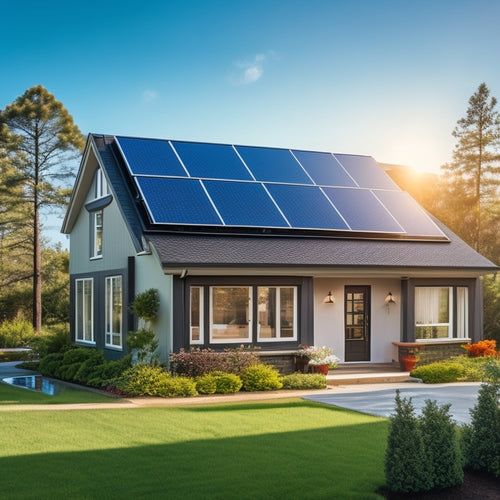
Comprehensive Guide to Household Solar System Setup
Share
You're about to invest in a household solar system, and it's essential to get it right; a well-designed system can save you thousands of dollars in electricity costs and increase your property value over its 30-year lifespan. To get started, you'll need to assess your daily energy consumption, understanding your usage patterns and peak consumption times to size your solar panel system correctly. You'll also need to choose the right equipment, including high-efficiency panels, an inverter, and mounting hardware, and consider your installation and mounting options, including fixed-tilt, adjustable-tilt, and trackers. Now that you've got the basics covered, you're ready to take the next step in designing a solar system that meets your unique needs and sets you up for long-term energy savings.
Key Takeaways
- Understanding solar panel characteristics, including type, benefits, and lifespan, aids informed decision-making for household solar system setup.
- Assessing daily energy consumption and usage patterns helps determine the required size and optimization of the solar panel system.
- Choosing the right equipment, including high-efficiency panels, inverters, and mounting hardware, is critical for maximizing energy production and reducing costs.
- Proper installation and mounting options, including fixed-tilt and adjustable-tilt brackets, ensure optimal energy harvesting and system durability.
- Real-time monitoring and maintenance of the solar system, including performance tracking and energy output analysis, ensure long-term efficiency and reliability.
Understanding Solar Panel Systems
Your expedition to utilizing renewable energy begins with a clear understanding of solar panel systems.
You'll want to familiarize yourself with the different solar panel types, each with its unique characteristics, advantages, and disadvantages. Monocrystalline silicon panels offer high efficiency, while polycrystalline silicon panels provide a more affordable option. Thin-film panels, on the other hand, are flexible and lightweight.
Understanding the benefits of solar energy is essential in making an informed decision. Solar energy benefits include reduced carbon footprint, lower electricity bills, and increased property value. Additionally, solar panel systems require minimal maintenance and have a long lifespan of up to 30 years or more.
When selecting a solar panel system, consider factors such as the system's wattage, voltage, and compatibility with your electrical infrastructure.
Assessing Your Energy Needs
You'll need to determine your daily energy consumption in kilowatt-hours (kWh) to size your solar panel system correctly.
To do this, you'll want to analyze your energy usage patterns, including the times of day when you use the most energy, as well as your current energy costs, which can be found on your utility bills.
Daily Energy Consumption
To accurately size a household solar system, one must first determine the daily energy consumption of the property. This involves calculating the total amount of energy your home uses on a daily basis.
You'll need to assess your energy efficiency and consumption habits to get an accurate estimate. Start by making a list of all the appliances, lighting, and devices in your home, along with their respective wattage ratings. Then, estimate the number of hours each device is used daily.
Next, calculate the total daily energy consumption in watt-hours (Wh) by multiplying the wattage of each device by the number of hours it's used. For example, if you have a 10W LED light that's used for 8 hours a day, its daily energy consumption would be 80Wh.
Add up the daily energy consumption of all devices to get your total daily energy needs. This information will help you determine the required size of your solar panel system and guarantee it can meet your energy demands.
Energy Usage Patterns
Energy usage patterns play a critical role in determining the required size of a household solar system, as they reveal the ebbs and flows of energy demand throughout the day.
By understanding your energy usage patterns, you can optimize your solar energy system to meet your specific needs, maximizing the solar energy benefits and minimizing your reliance on traditional energy sources.
To assess your energy needs, you'll need to identify the times of day when your energy demand is highest.
Are you a morning person who fires up the coffee maker and turns on the lights as soon as you wake up?
Or do you work from home and use energy-intensive equipment throughout the day?
Knowing your energy usage patterns will help you determine the size of the solar array and battery storage you'll need to guarantee a reliable supply of renewable energy.
Current Energy Costs
Understanding your energy usage patterns is just the first step in determining the size of your household solar system.
Now, it's time to assess your current energy costs. You need to know how much you're paying for electricity each month and how that amount varies throughout the year. Review your past electricity bills to identify energy price trends and patterns. This will help you determine the total kilowatt-hours (kWh) you consume annually.
Conduct an electricity rate comparison to determine your cost per kWh. This is usually measured in cents per kilowatt-hour (¢/kWh). You can find this information on your utility bills or by contacting your electricity provider.
Knowing your energy costs will help you determine the financial benefits of a solar system and how long it will take to recoup your investment. With this information, you can accurately size your solar system to meet your energy needs and start generating clean, renewable power for your home.
Choosing the Right Equipment
Selecting the perfect solar panel system for your household requires careful consideration of several critical components.
You'll need to assess your energy needs, evaluate the performance of different solar panels, and choose the right inverter and mounting hardware. With rapid solar technology advancements, it's crucial to select high-efficiency panels that maximize energy production.
Consider the wattage, voltage, and temperature coefficient of each panel to guarantee peak performance.
When evaluating inverters, look for high-efficiency models with advanced features like maximum power point tracking (MPPT) and monitoring capabilities.
You'll also need to decide on a mounting system that suits your roof type and size.
Don't forget to investigate equipment financing options, such as loans or power purchase agreements, to make your solar investment more affordable.
Installation and Mounting Options
Now that you've chosen the ideal solar panel system for your household, it's time to focus on the physical installation and mounting of your equipment. This essential step requires careful contemplation to guarantee a secure, efficient, and long-lasting setup.
When selecting a mounting option, you'll need to evaluate your roof type. Asphalt shingle, metal, tile, and flat roofs each pose unique challenges and requirements. For instance, asphalt shingle roofs often use traditional rail-mounted systems, while metal roofs may employ standing-seam clamps. Tile roofs, on the other hand, require specialized tile hooks to prevent damage.
Mounting brackets are a vital component of your installation. You'll need to choose between fixed-tilt, adjustable-tilt, and trackers. Fixed-tilt brackets provide a cost-effective solution, while adjustable-tilt brackets allow for seasonal adjustments to optimize energy production. Trackers, though more expensive, offer maximum energy output by following the sun's movement.
Evaluate factors like durability, adjustability, and wind resistance when selecting the ideal mounting brackets for your solar panel system.
Connecting to the Grid
With your solar panel system securely mounted, you're ready to harness the power of the sun by connecting to the grid. This connection allows you to feed excess energy back into the grid and offset your energy consumption during periods of low solar production. To achieve this, you'll need to confirm your system meets the necessary utility regulations.
You'll need to install a grid-tie inverter, which converts DC power from your solar panels to AC power compatible with the grid. Additionally, you'll need to install a net meter, which measures the energy you produce and consume.
Here's a breakdown of the key components involved in connecting to the grid:
| Component | Function |
| Grid-Tie Inverter | Converts DC power to AC power |
| Net Meter | Measures energy production and consumption |
| Utility Approval | Confirms compliance with utility regulations |
Monitoring and Maintenance Tips
You'll want to keep a close eye on your system's performance to guarantee it's running at its best, which is where system performance tracking comes in.
This involves monitoring key metrics like energy output, consumption, and grid interaction to identify areas for improvement.
System Performance Tracking
Ideal energy harvesting relies on detailed system performance tracking, an essential aspect of ensuring your household solar system operates at its peak capability.
By monitoring your system's performance, you can identify areas for improvement, enhance energy production, and maximize your return on investment.
To achieve peak system efficiency, you should:
- Monitor your system's energy production in real-time, allowing you to detect any anomalies or performance issues
- Track your system's performance metrics, such as energy output, voltage, and temperature, to identify opportunities for performance enhancement
- Receive alerts and notifications when your system's performance deviates from expected levels, enabling you to take prompt action to address any issues
Energy Output Analysis
Your household solar system's energy output is a direct reflection of its overall performance, and analyzing it's key to optimizing your energy harvesting capabilities.
To guarantee maximum solar efficiency, you'll want to monitor your system's energy output regularly. This involves tracking the amount of electricity your system produces daily, weekly, and monthly.
You can do this using a monitoring system, which provides real-time data on your energy production.
Frequently Asked Questions
Can I Install a Solar System on a Rented Property?
You can install a solar system on a rented property, but it's essential to understand renter rights and investigate installation options with your landlord, such as a solar lease or power purchase agreement, to guarantee a mutually beneficial arrangement.
How Do I Handle Snow Accumulation on Solar Panels?
Snowflakes gently falling on your solar panels, but at what cost? You'll need to brush or blow them off regularly to prevent energy loss, as snow accumulation can slash solar panel performance by up to 50% - time to master snow clearing techniques!
Are Solar Systems Compatible With Septic Systems?
You guarantee solar system compatibility with septic systems by considering septic tank location, avoiding panel placement nearby, and prioritizing regular solar panel maintenance to prevent contamination, guaranteeing both systems operate efficiently and safely.
Do Solar Panels Affect Wi-Fi and Cellular Signals?
You won't typically experience significant solar interference from your panels on Wi-Fi and cellular signals, but signal strength can be affected if the panels are installed near antennas or obstruct signal paths, so careful planning is essential.
Can I Add More Panels to My Existing Solar System?
As you ponder upgrading your solar setup, you're wondering: can I add more panels? The answer hangs in the balance, dependent on panel compatibility and your system's capacity to handle increased power output - a delicate dance of voltage and current.
Related Posts
-

Why Electric Motorcycles Fail at Long-Distance Touring
You're likely familiar with the excitement of hitting the open road on an electric motorcycle, but you're also smart ...
-

Planning for an Electric Vehicle-Friendly Urban Future
As you plan for an electric vehicle-friendly urban future, you'll need to integrate high-power charging stations, sma...
-

Solar Power Units Perfect for Homes
You're considering installing a solar power unit in your home, a decision that can notably reduce your reliance on tr...


